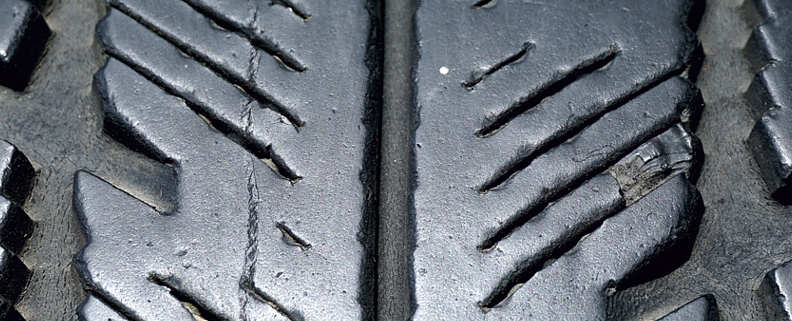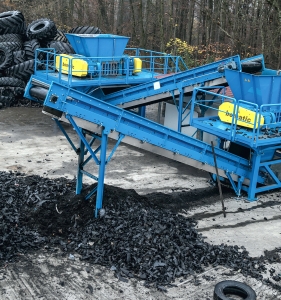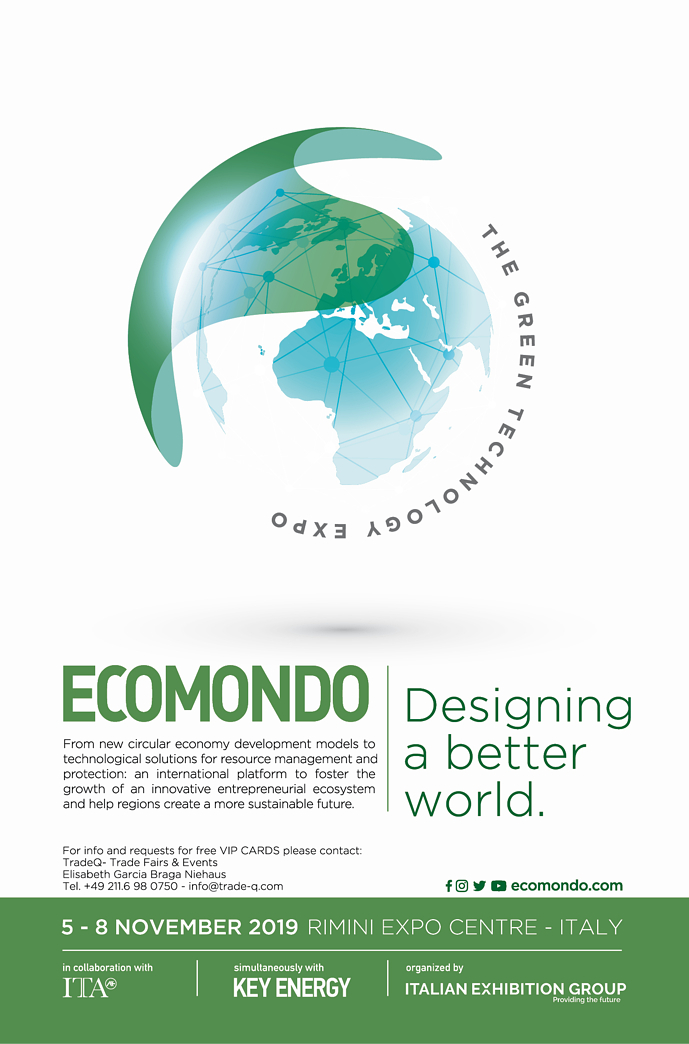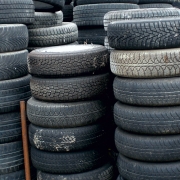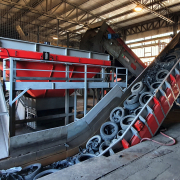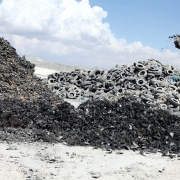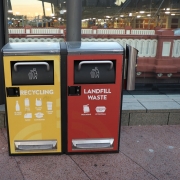Tire Recycling Riding On
The materials of end-of-life tires are useful for nearly endless applications. The way these tires are collected (or disposed of), recycled (or burnt) and brought to market (or stored), are not endless, but differ widely from country to country. However, the global progress of recovering the material can hardly be stopped.
European Union: Recycling increased
In June 2013, the Tyres-Committee of the Bureau of International Recycling carried good news: “Latest figures suggest that the tire recovery rate in Europe has reached an all-time high of 98 percent compared to 75 percent as recently as 2004, thus reducing landfilling to very low levels.” According to ETRA, the European Tyre Recycling Association, at that time the recovery rate of end-of-life tires (ELT) in Europe was 96 percent on average. Most countries reached 100 percent, five nations ranged between 90 and 70 percent, while the rates of the Balkan states laid lower or were unknown. The main treatment methods for rubber were recycling and incineration with energy recovery at the ratio of 54 to 45 percent.
In 2016, the volumes’ situation in EU28 showed 117,000 tons of end-of-life tires used for civil engineering, public works and backfilling as well as 1,630,250 tons recycled. 999,750 tons went to energy recovery, 160,000 tons were landfilled or ended unknown; tires on stock reached 49,000 tons. Used tires arising added up to 3,515,000 tons and the reuse of part-worn tires by retreading, reuse or export included 561,000 tons. So, a total of 3,306,000 tires was treated, reaching a treatment rate of 95 percent, according to the European Tyre & Rubber Manufacturers Association (ETRMA). In the long term, the energy recovery of ELT between 1995 and 2014 declined from 53 to 37 percent, reuse and retreading of part worn tires was reduced from 34 to 27 percent, while recycling rose from 13 up to 35 percent.
Different systems
In 23 European nations, the handling of ELTs is managed by an Extended Producer Responsibility and followed through in various ways from a single ELT management company dealing with ELT collection and treatment in a country (such as in Portugal, the Netherlands or Sweden), through multiple ELT management companies (such as in Italy, France or Spain) or through individual producer responsibility (in Hungary). Free market systems operate among others in Austria, Switzerland, Germany, and the UK: Here the operators contract under free market conditions and act in compliance with the legislation, that sets the objectives to be met but does not designate those responsible. Under the tax system – applied in Denmark and Croatia – the country is responsible for the management of ELTs: A tax is levied on tire producers and subsequently passed on to the consumer. Fazilet Cinaralp, Secretary General of ETRMA, noted in 2016 that the tire industry “clearly supports the EPR model when it is backed by clear statutory requirements and provides a separate line on the invoice, showing the environmental contribution for ELT management, ensuring full transparency for both national authorities and to the end consumer.” But the CEO added that “EU harmonized end-of-waste criteria for ELT granulates and powder are also needed to ensure a level playing field between virgin and secondary raw materials.”
Material recovery mostly by granulation
Looking at the utilization, 1.1 million tons were energetically recovered by 81 percent in cement kilns and by 19 percent in urban heating and power plants in EU28, Switzerland, Norway, Serbia, and Turkey. The material recovery of 1.9 million tons took place mostly by granulation (75 percent), by incorporation in cement (15 percent) and among others one percent by steel mills and foundries and one percent by pyrolysis. Latest statistics indicate that 75 percent of Europe’s ELTs destined for material recovery – equivalent to more than 1.4 million tons per annum – are channeled into granulation, for which end-use applications “remain a challenge”, Fazilet Cinaralp gave account in October 2018.
Looking for new markets
Already two years ago she had underlined that the figures indicate a “saturation of the ELT granulation market in Europe”. It would be time for new markets for rubber granulate to be found to further develop European tire recycling. ETRMA’s “End-of-life Tyre Report 2015” proposes a higher use of rubber in concrete – “this market is sure to grow” –, more adoption of rubberized asphalt – “a very promising market” –, an utilization in the surface of athletic tracks – “by nature, perfectly suited to the criteria” –, possibilities in noise mitigation and anti-vibration solutions and applications in the transport area, as “the rail and tramway sector offers a huge potential for the use of tire-derived materials”. In this sense, a series of projects have been launched by ETRA: Anagennisis focusing on innovative reuse in concrete, Eco-Lanes developing infrastructure for surface transport, Isol-Eco searching a viable solution for tire textiles, Persuade developing and testing new road pavements, Roadtire innovatively using recycled tire rubber in road construction, Smart Project optimizing the use of only recycled tire granulate and powder without additives, Twincletoes converting a waste bi-product, TyGRe Project recovering high added-value products from selected waste streams, and Woodrub innovating environmental friendly products made from recycled wood and recycled tire rubber.
The necessity of sustainable treating end-of-life tires in Europe was emphasized by Elroy Fimrite at the 23rd Annual European Tyre Recycling Conference in March 2016. The President at EFG America LLC, a devulcanization technology firm, believed and stated “that there were finite sources of natural rubber, and when the Chinese economy, in particular, was in a position to expand fully, there would be only one solution for the tire manufacturers and that would be to fall back on recycled tire rubber materials”.
USA: value of the material recognized
Around 300 million tires are annually scrapped in the United States, according to the U.S. Tire Manufacturers Association. In the past, scrap tires were often dumped illegally in lakes, abandoned lots, and along the side of the road. Nowadays, the United States has recognized the value of the material. Latest figures published by the association in 2017 indicate that 4.189 million tons of scrap tires were generated, of which 3.411 million tons went to market or were destined for sale – a utilization rate of 81.4 percent. Adding this, the baled and the landfilled material (646,000 tons), the managed tire scrap reached a rate of 96.9 percent. 1,736,340 tons respectively 43 percent were used as tire-derived fuel in cement kilns, pulp and paper facilities and industrial boilers. 1.013 million tons respectively 25 percent got granulated for ground rubber solutions, 315,000 tons respectively eight percent fulfilled civil engineering purposes, and 109,000 tons respectively three percent were exported.
Scrap tire material volume declined
Between 2009 and 2017, the percentage of scrap tire material dedicated to the market to total generated material declined from 85.3 – with an all-time height of 95.9 in 2013 – to 81.4 percent. The tire-derived fuel usage diminished from 2.085 to 1.736 million tons: The share of fuels used in cement kilns has increased from 2009 to 2017 from 604,000 to 806,000 tons and the use in utility boilers from 326,000 to 427,000 tons. But the utilization in pulp and paper mills sank from 716,000 to 503,000 tons, while the share of fuel burned in industrial boilers or dedicated to energy recovery declined to zero. And even the ground rubber market lost volume: The market distribution declined from 1.354 to 1.013 million tons. In spite of the fact, that ground rubber applications accounted for 25 percent of scrap tire usage in 2017. The number of stockpiled scrap tires that had reached one billion tons in 1990 was cleaned up by 94 percent in 2017, leaving 60 million stockpiled tires to go – mostly in Colorado and Texas.
The decline is predominantly caused by negative public opinion. Or as ISRI President Robin Wiener expressed it in October 2018: “The market in America has dipped by perhaps 30 percent over the last two to three years owing to negative media reports of safety concerns – even though some 100 studies have concluded that no such safety risk exists.” The Safe Healthy Playing Fields Coalition gives an example: This national acting coalition is “working to alert communities, schools, and individuals to rising concerns over the hazards of synthetic turf athletic fields”. It operates an internet website to counter “misinformation and inaccurate studies” and published in January 2017, that “currently 4,760,000,000 pounds of loose, unencapsulated, pulverized waste tires are spread across play surfaces of more than 12,000 fields in schools, sports centers, and playgrounds”, affecting hundreds of thousands of players and families, including school children across the US”.
Federal states enacting schemes
Even if, as the Coalition underlines, “no government agency has concluded artificial turf is safe”, the federal states in Northern America started to enact schemes for supporting scrap tire treatment. 44 of 50 states have storage and disposal regulations, 36 require financial assurances for processors, and 17 demand financial assurance for haulers. 38 states allow the landfilling of cut or shredded tires, 24 allow their mono-filling, and ten allow the landfilling of whole tires. 30 states display a stockpile cleanup program, while in 23 states a stockpile cleanup program is operating. Several tire recycling grants are offered, for example in Kansas by the Bureau of Waste Management, in Nebraska backed by the Department of Environmental Quality, in Ohio by the Environmental Protection Agency and the Lorain County Community Development Department, and in California for the funding of road repair programs using recycled tires.
Several associations and organizations are active in the scrap tire branch. For example, the Rubber Pavements Association (RPA), dedicated to the promotion of greater use of high quality, cost effective asphalt pavements containing recycled scrap tire rubber and associated with among others the International Tire and Rubber Association, the European Tyre Recycling Association, the Scrap Tire Management Council, and the National Asphalt Pavement Association. The Synthetic Turf Council represents companies who consult, design, install, test, maintain and reclaim synthetic turf sports systems and synthetic grass for landscape and recreation, as well as manufacturers and suppliers of related materials and equipment. The Tire Retread & Repair Information Bureau has the mission to promote and defend the tire retread and tire repair industries worldwide. The Canadian Association of Tire Recycling Agencies is made up of tire recycling agencies in the provinces and territories of Canada and has programs in place to ensure the proper management of end of life tires. [Information on the Rubber Manufacturers Association (RMA), established in 1915 as the Rubber Club of America and in 2010 heralding the 20th anniversary of the creation of its Scrap Tire Management Council (STMC), can no more be found.]
For a competitive free market system
Not all associations are convinced of the political course in scrap tire recycling. In 2015 the Tire Industry Association (TIA), an international non-profit confederation, had published a statement underlining promotion and support for a competitive, market-based management system for the flow of scrap tires and scrap tire materials. In contrast to the “highly successful” free enterprise system of scrap tire management, the legislation in some states introduced an Extended Producer Responsibility or Product Stewardship bills, “that would restrict or interfere with the free flow of scrap tires to selected markets”. It “would create an additional level of management or oversight, would add costs without any significant benefit, would remove the retailer from direct negotiations with their suppliers and would replace an efficient well established free market-based system for managing scrap tires with an unproven system.” TIA Executive Vice President Roy Littlefield was sure: “TIA supports a competitive free market system that does not interfere with the free flow of scrap tire recyclable materials.”
China: dangerous and unsafe practices
Published in September 2010 by China’s Ministry of Industry and Information, a new strategic policy document set the path for the country’s tire industry – covering all parts from encouraging investment in regional natural rubber production over improvements in energy efficiency in tire factories to the responsible disposal of waste tires. Such rules were obviously necessary as in 2012 a reporter from the Qilu Evening News wrote about the practices in China’s small tire recycling branch: “The report outlines dangerous and unsafe practices; the attempted repair of irreparably-damaged tires; burning of tires in the open and other; ‘no questions asked’ practices,” the contemporary witness was quoted. This reflects the situation of the tire industry that is highly fragmented and often works on very limited margins. “Most of the mid-scale Chinese producers operate on wafer-thin margins, thus, even a marginal change in raw material prices often results in a number of hardships for the mid- and small-scale producer”, the China Rubber Industry Association gave account in Summer 2018.
Anyway, China’s automobile industry has been developing fast. According to a China tire industry report, China was the world’s largest automobile manufacturer and the largest sales market between 2009 and 2016. “The increased production volume and reserve volume of automobiles in China stimulates the demand for automobile tires.” And the demand for appropriate materials. As China is regarded to be the world’s largest producer of natural rubber and has other rubber resources and purposes of the usage of rubber, recycled tires are only one option to advance the material stock. This is shown at the China Rubber Industry Association, where the “tire branch” ranks among 14 other subdivisions, even if the total generation amount of scrap tires in China and the U.S. is estimated to reach 500 million and total weights of about ten million tons.
Attention growing
To facilitate the industrial transformation and upgrade as well as improve the whole level of the renewable resources industry, the Ministry of Industry and Information Technology in 2015 confirmed the so-called “Major national resources recycling demonstration engineering” and released a notice. It launched nine projects of tire rubber waste utilization. The listed schemes included amongst others projects for 300,000 tons of waste tires rubber construction, for tire recovery and whole industry chain resources recycling, for major intelligent clean demonstration engineering of 130,000 tons, for disposal and recycling of 200,000 tons per year, and for the improvement of an 11,000-ton waste tires production line.
In the same year, the automobile industry began to pay attention to rubber recovery. Li Guo Qing, managing director at China Automobile Parts Holdings Ltd, saw a growing request in China to recycle rubber tires and other rubber waste products. He was quoted with the words: “China being the world’s biggest automobile market represents a huge demand for this technology. There is an enormous gap in the market for those looking for ways to dispose of used tires.”
The Catalogue for Investment
In 2015 too, the Chinese government reacted to the climate change, adopted the 13th Five Year plan and released a Catalogue of Industries for Guiding Foreign Investment. According to business information China Briefing Magazine, the Chinese government – to reform the country’s recycling industry – needed among others investment in foreign technology and expertise to develop urban recycling facilities and modern treatment and reprocessing practices. The Catalogue was revisited in 2017 and includes a need for capital spending on the manufacturing of equipment for the collection, treatment and recycling of used and waste plastics, electrical appliances, rubbers and batteries. And offers foreign financial input at recycling and treatment of waste and used electrical and electronic products, automobiles, electromechanical equipment, rubbers, metals, and batteries.
First joint ventures
The industry followed the call. In December 2011, UK based supplier of mechanical components Blue Diamond Technologies and its Canadian Affiliate ECO/BDT formed a joint venture with Insigma Technologies of China. Matter: the establishment of overall 13 facilities for the production of reusable crumb rubber, clean steel, and fiber from used vehicle tires. In March 2014, Sweden-based Enviro Systems AB signed a memorandum with state-owned Vanlead Group, southern China’s largest tire manufacturer, for a tire recycling plant in China. It was planned to use Enviro’s reclaimed carbon black material in Vanlead’s tire production of 30,000 tons of tires annually. In June 2015, the Central China Rubber Resources Recycling Industrial Park in Xiangyang broke ground. 340 million US-Dollar funding was planned to make it the country’s largest rubber recycling park with a capacity of 300,000 tons per year for rubber modified asphalt and 100,000 tons per annum for recycled rubber.
Industry 4.0 rubber recycling
In October 2017, US-based tire recycling systems producer ECO Green Equipment announced the completion of a new rubber powder tire recycling plant in Maanshan, China. The new system providing the latest tire recycling technology for the city was handed over to the Anhui GVG New Material Co., Ltd. In December 2017, Swiss cleantech startup Tyre Recycling Solutions signed a strategic alliance with the Longjiang Environmental Protection Group to open a factory in China by 2019. And in January 2018, Chinese tire manufacturer Doublestar announced to build an innovative scrap rubber recycling plant in Zhumadian. Nearly 93 million US-Dollar investments are intended to deliver an annual capacity of 200,000 tons to completely recycle scrap tires and produce carbon black, fuel oil, synthetic gas, and steel wire. According to Doublestar, the plant will become the world’s first “Industry 4.0 plant” for scrap rubber recycling, which will use innovative machinery for procedures such as rinsing, sorting, conveying, storage, drying and pyrolysis process.
A scientific study comparing tire recycling in the United States and China comes to the conclusion: “Management policies on scrap tires in the U.S. are more comprehensive and stricter than those in China. … In the U.S. co-disposed as an alternative fuel is the main outlet for scrap tires, while in China they are mainly recycled to produce reclaimed rubber.”
A global trend
Of course, waste tire recovery is not limited to Europe, the USA, and China. The struggles to treat the material in a financially available and under circumstances environmentally acceptable manner are spread globally. In India for example, the Gujarat Pollution Control Board in 2011 had to shut down 45 oil-producing pyrolysis units since they used substandard and polluting technology imported from China – equipment meanwhile banned in China itself. Redisa, the Recycling and Economic Development Initiative of South Africa, started a system in which waste pickers would collect 30 million waste tires, based on “the polluter pays” principle. But instead of creating jobs and improving the environment as promised, it turned out to be a “get-rich-quick scheme for a small group of individuals”.
In Russia, tire manufacturers have to fulfill recycling norms including 20 percent in 2017-2018, 25 percent in 2019, and 30 percent in 2020. Additionally, in January 2017 EcoTyres Union was founded in Moscow for independent compliance with the recycling targets of used tires by international tire manufacturers like Bridgestone, Continental, Hankook, Michelin, Nokian Tyres, Pirelli, and Yokohama. In Colombia, mining company Carbones del Cerrejon Ltd. inaugurated Latin America’s first large-tire recycling plant in 2016. And Australian’s Tasmania ABC.net reported that Launceston City Council had given the green light to Phoenix Rubber Products to develop a tire recycling plant for the production of traffic calmers, bollards and playground and equestrian surfaces – products that currently have to be imported, while waste tires are bailed and exported to China for recycling.
The fields of activity for waste tire recycling are increasing. Stated in numbers, the elastomers market will grow by 13 percent per year from 2018 to 2025, according to Global Market Insights Inc.
Photo: webandi /Pixabay
(GR 22019, Page 4)

